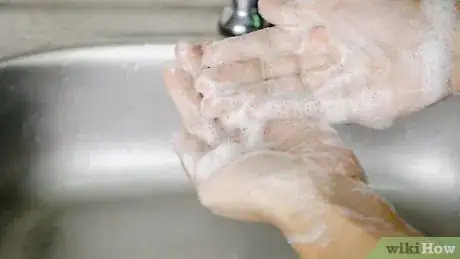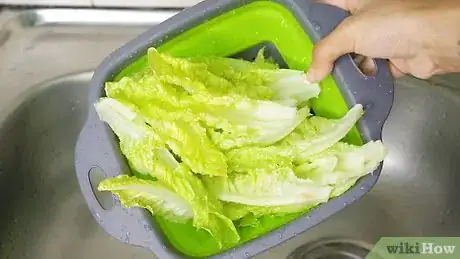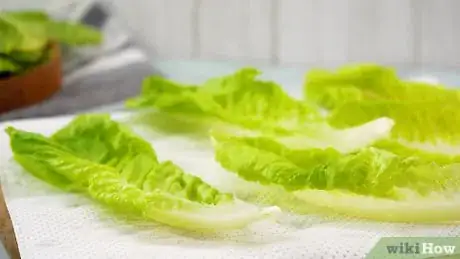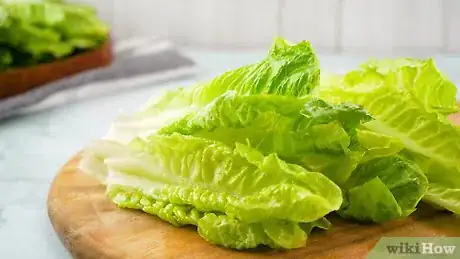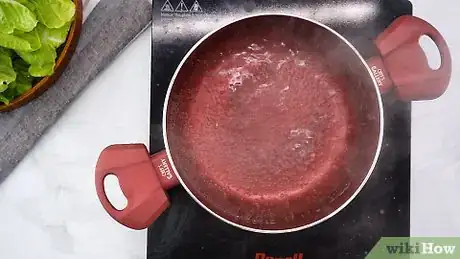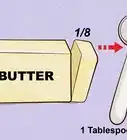This article was co-authored by wikiHow staff writer, Janice Tieperman. Janice is a professional and creative writer who has worked at wikiHow since 2019. With both a B.A. and M.A. in English from East Stroudsburg University, she has a passion for writing a wide variety of content for anyone and everyone. In her free time, you can find her working on a new crochet pattern, listening to true crime podcasts, or tackling a new creative writing project.
There are 14 references cited in this article, which can be found at the bottom of the page.
The wikiHow Video Team also followed the article's instructions and verified that they work.
This article has been viewed 40,394 times.
Learn more...
Romaine lettuce is a delicious complement to any meal, but you might be hesitant to use it due to its past involvement in several past E. coli outbreaks. If your national health organization hasn’t issued a warning, you can use cold running water and paper towels to wash and pat dry your romaine lettuce leaves. If you aren’t sure if your lettuce leaves are contaminated or you just want to play it extra safe, feel free to boil or cook the romaine instead.
Steps
Rinsing with Water to Remove Dirt and Bugs
-
1Wash your hands before handling romaine lettuce. Lather your hands with soap and rub it between your fingers, beneath your fingernails, and all over the rest of your hands. After you’ve done this for 20 seconds, wash your hands off with cool water to remove any suds.[1] Make sure to dry your hands off completely before working with the lettuce.[2]
- For reference, sing “Happy Birthday” to yourself twice as you wash. Once you’ve sung this twice, you can rinse off your hands.
-
2Pull off and throw out the outer romaine leaves. Find the leaves surrounding the outside of the lettuce head and pull them off from the base. Once you’ve removed the outer leaves, grind them up in your sink disposal or throw them out in the trash.[3]
- These leaves typically have the most germs and dirt, so it’s important to throw them out.
Advertisement -
3Remove and rinse each lettuce leaf under cold faucet water. Pluck off each romaine leaf individually from the base as you make your way to the plant’s center. Turn on your faucet to a cool water setting, and rinse off each leaf beneath the tap. Make sure that both sides of the leaf are rinsed off as you go.[4]
- Don’t soak the leaves in a large bowl or salad spinner, as this helps pathogens to spread to the other lettuce leaves.
-
4Scrub each leaf with your fingers to clean off dirt and germs. Use short, vertical movements to rub away any excess dirt from the leaves. If the leaf seems especially dirty or dusty, take extra care to clean it. Once you’ve finished rinsing and scrubbing each piece of romaine, set it aside in a salad spinner or colander.[5]
- Wash your hands after you’ve cleaned off the romaine.
Drying and Storing Romaine Lettuce
-
1Drain the leaves in a colander or salad spinner for 5 minutes. Let any lingering water drip out of the salad spinner or colander. Wait 5 minutes for the romaine leaves to drain completely. To make the process quicker, avoiding spraying the romaine leaves with any more water once you’ve set them aside.[6]
- It’s easiest to do this over the sink.
-
2Pat each lettuce leaf dry with a paper towel. Remove each piece of lettuce individually and blot each leaf lengthwise with a paper towel. Be sure to dry off both sides as you go. Consider drying the leaves somewhere away from the sink.[7]
-
3Set each piece of lettuce aside on a paper towel. Keep the romaine leaves on a flat surface, like a kitchen counter.. Wait a few minutes for any lingering moisture to evaporate thoroughly.[8]
- Although it may be tempting to stick your wet romaine leaves in the fridge, drying them with paper towels helps to remove any lingering bacteria.
-
4Refrigerate the leaves in a plastic bag or open container. Take the dried pieces of romaine and arrange them in a plastic bag or open container. Stack the leaves on top of one another along with a few paper towels to soak up any extra moisture.[9] Keep the plastic bag or container open slightly, and store it in the bottom of the refrigerator at 40 °F (4 °C) or less.[10]
- Keep an eye on these paper towels while you store the lettuce. If they get too moist throughout the week, feel free to replace them.
-
5Use the lettuce within 7-10 days. Plan on using the romaine in a salad or other recipe within the week, as the lettuce won’t last for more than a week and a half.[11] Although it might feel like you’re saving space, don’t tie up the romaine leaves with a rubber band, as this prevents the produce from feeling as fresh as possible.[12]
Sanitizing Your Romaine
-
1Boil water in a pot to sterilize the romaine. Fill a pot at least two-thirds of the way full with water. Set it on the stovetop before turning on the heat to the highest setting. Wait for the water to reach a rolling boil, or when streams of bubbles are rapidly rising to the top of the water.[13]
- If you want to play it safe, check and make sure that the water is at least 160 °F (71 °C).[14]
- You can also boil water with a kettle or in the microwave.
-
2Place the romaine leaves in the boiling water for 15 seconds. Use tongs to transfer the lettuce leaves you’d like to sanitize to the pot of boiling water. Let the leaves sit in the boiling water for at least 15 seconds to kill any bacteria. [15]
- Keep in mind that the romaine won’t be as fresh or crunchy after it’s boiled.[16]
-
3Drain the boiled leaves in a colander. Place a clean colander in your sink and pour the boiling water over it, allowing the romaine leaves to separate into the colander. Make sure that you’re using gloves or potholders whenever you’re handling anything that’s boiling.[17]
- This process is identical to straining pasta.
-
4Wait 5 minutes for the lettuce to cool. Check periodically to see if the lettuce feels hot to the touch. To monitor this, hold your hand a few inches or centimeters over the lettuce to see if the leaves are still steaming. Wait until the romaine is warm enough to touch before handling it further.
- If you’d like to make the drying process go more quickly, try laying the leaves out in a single layer.
-
5Sauté or cook the lettuce leaves if you don’t want to boil them. Change up your routine by preparing your romaine in a way that’s both healthy and delicious. Thankfully, any cooking method that involves high heat will sterilize and remove any harmful bacteria from romaine, so try sautéing the greens to make them ready to eat.[18]
Warnings
References
- ↑ https://www.cdc.gov/features/handwashing/index.html
- ↑ https://www.fda.gov/consumers/consumer-updates/7-tips-cleaning-fruits-vegetables
- ↑ https://www.cbc.ca/news/canada/prince-edward-island/pei-romaine-lettuce-food-safety-colleen-walton-upei-1.4482961
- ↑ https://www.cdc.gov/foodsafety/keep-food-safe.html
- ↑ https://www.cbc.ca/news/canada/prince-edward-island/pei-romaine-lettuce-food-safety-colleen-walton-upei-1.4482961
- ↑ https://www.cbc.ca/news/canada/prince-edward-island/pei-romaine-lettuce-food-safety-colleen-walton-upei-1.4482961
- ↑ https://www.fda.gov/consumers/consumer-updates/7-tips-cleaning-fruits-vegetables
- ↑ https://www.fda.gov/consumers/consumer-updates/7-tips-cleaning-fruits-vegetables
- ↑ https://www.tasteofhome.com/article/tips-tricks-keep-lettuce-fresh/
- ↑ https://www.cdc.gov/foodsafety/keep-food-safe.html
- ↑ https://www.tasteofhome.com/article/tips-tricks-keep-lettuce-fresh/
- ↑ https://www.bonappetit.com/story/how-to-store-vegetables
- ↑ https://www.health.ny.gov/environmental/water/drinking/boilwater/faq_residents_and_homeowners.htm
- ↑ https://www.latimes.com/archives/la-xpm-2006-oct-14-me-spinachbox14-story.html
- ↑ https://www.latimes.com/archives/la-xpm-2006-oct-14-me-spinachbox14-story.html
- ↑ https://www.thekitchn.com/lettuce-is-so-much-more-than-salad-here-are-10-more-ways-to-eat-it-tips-from-the-kitchn-220136
- ↑ https://www.today.com/food/how-properly-drain-pasta-viral-hack-t117091
- ↑ https://www.treehugger.com/health/how-avoid-e-coli.html
- ↑ https://www.allrecipes.com/recipe/222720/grilled-romaine/
- ↑ https://www.epicurious.com/recipes/food/views/stir-fried-garlic-lettuce-233211
- ↑ https://www.cdc.gov/foodsafety/keep-food-safe.html
- ↑ https://www.cdc.gov/ecoli/2018/o157h7-11-18/index.html
- ↑ https://www.cdc.gov/ecoli/2018/o157h7-11-18/index.html
- ↑ https://www.latimes.com/archives/la-xpm-2006-oct-14-me-spinachbox14-story.html
About This Article
The easiest way to wash romaine lettuce is to just separate the leaves and rinse and scrub them under cold running water. However, if you want to sanitize romaine because of an E. coli outbreak, bring a pot of water to a boil, then drop the separated leaves into the water for 15 seconds. Drain the leaves in a colander and wait 5 minutes for them to cool before using them. To learn how to dry and store romaine lettuce after washing it, keep reading!
